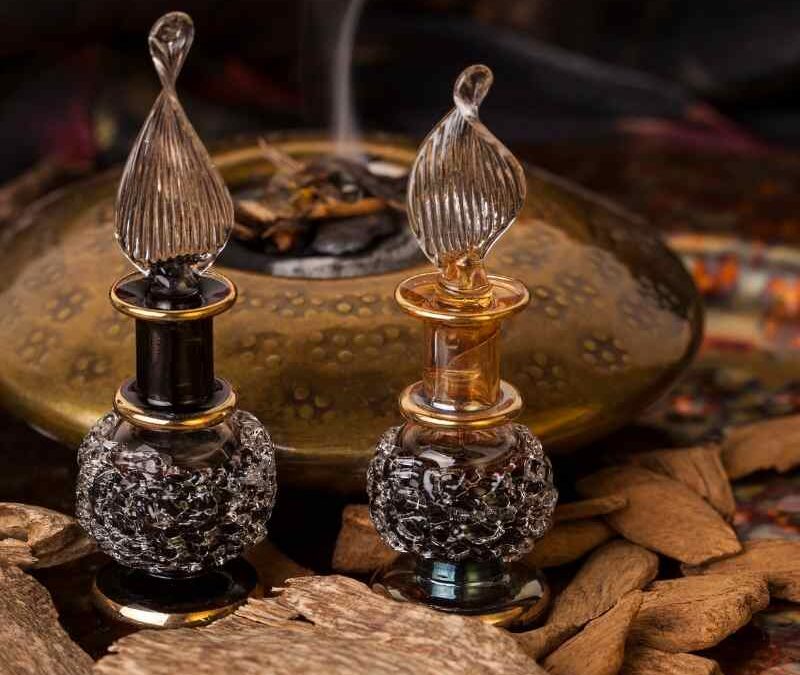A Journey into Agarwood Essential Oil Aroma, Blending Possibilities, Preservation And More!
Welcome to the intriguing world of Agarwood essential oil, also known as Oud oil or Aloeswood oil. In this in depth blog post, we’ll dive deep into the captivating scent and therapeutic qualities of Agarwood essential oil. Discover how to make this precious oil last longer while exploring its blending possibilities with other essential oils and understanding its sustainable preservation.
The Essence of Agarwood
Agarwood essential oil, derived from the resinous heartwood of the Agarwood tree (Aquilaria species), carries a rich history and cultural significance. Agarwood essential oil has a unique and captivating fragrance that is often described as woody, balsamic, sweet, and earthy. The aroma can vary significantly depending on the species, geographical origin, and age of the Agarwood.
Let’s explore its formation, extraction methods, and notable characteristics:
Agarwood Formation:
Agarwood is formed in the heartwood of Aquilaria trees when they become infected with a specific type of mold (Phialophora parasitica) or due to natural defense mechanisms. This infection triggers a chemical reaction within the tree, resulting in the formation of a resinous substance that eventually turns into Agarwood.
Extraction Methods:
Agarwood essential oil is obtained through a variety of methods, including hydro-distillation, steam distillation, and supercritical fluid extraction. Hydro-distillation is the most common method, where the Agarwood chips or powder are submerged in water and heated to release the oil.
Aroma:
Agarwood essential oil has a unique and captivating fragrance that is often described as woody, balsamic, sweet, and earthy. However, the aroma can vary significantly depending on the species, geographical origin, and age of the Agarwood.
Agarwood Essential Oil Uses and Benefits
Agarwood essential oil offers numerous benefits for your well-being and sensory pleasure. Let’s explore its versatile uses and potential therapeutic properties:
Perfume:
Agarwood is highly prized in the perfume industry and is used as a base note in many luxury fragrances. An example of a luxury perfume brand is Dior Leather Oud: Leather Oud from the exclusive Maison Christian Dior collection is a refined and luxurious fragrance that features agarwood alongside leather notes. The combination of agarwood, leather, and smoky nuances creates a rich and distinctive olfactory experience.
Aromatherapy:
Unlock the calming, grounding, and spiritual properties of Agarwood oil. Agarwood is ideal for enhancing relaxation, reducing stress, and supporting meditation practices. Agarwood essential oil is valued for its relaxing, grounding, and spiritual properties and is used in various aromatherapy practices.
Traditional Medicine:
Agarwood has been used in traditional medicine systems, including Ayurveda, for its potential health benefits. Agarwood in traditional medicine systems, is exploring its potential benefits such as analgesic, anti-inflammatory, and antimicrobial properties.
Incense and Ceremonial Purposes:
Agarwood chips, powder, or essential oil are often used in religious and ceremonial practices.
Blending Possibilities
Agarwood essential oil harmonizes beautifully with various other essential oils, creating unique and captivating fragrance combinations. Here are some essential oils that blend well with Agarwood:
- Sandalwood: Enhances the woody notes and adds depth to Agarwood’s aroma.
- Patchouli: Complements the earthy qualities of Agarwood, creating a warm and grounding blend.
- Rose: Adds a delicate and floral touch to the rich woody scent of Agarwood.
- Frankincense: Enhances the spiritual and meditative properties of Agarwood with its resinous and uplifting aroma.
- Vetiver: Complements the deep and resinous notes of Agarwood with its smoky and earthy scent.
- Cedarwood: Shares woody characteristics with Agarwood, adding freshness and astringency to the blend.
- Bergamot: Provides a bright and refreshing element to Agarwood with its citrusy and uplifting scent.
- Jasmine: Adds a sensual and luxurious note to Agarwood with its rich and intoxicating floral aroma.
Essential Oils Similar to Agarwood
While Agarwood has a truly unique aroma, some essential oils possess similar characteristics or evoke a comparable vibe. Here are a few essential oils that share certain qualities with Agarwood:
- Amyris: Known as “West Indian Sandalwood,” it has a warm, woody, and balsamic aroma reminiscent of Agarwood.
- Copaiba: Offers a sweet, resinous, and earthy scent similar to Agarwood, though less complex.
- Guaicwood: With its rich and smoky aroma, Guaicwood can be reminiscent of Agarwood, creating a woody and grounding experience.
Strategies to Preserve Agarwood Essential Oil
To make the most of your Agarwood essential oil, here are effective ways to ensure its longevity and value:
- Proper Storage: Storing Agarwood oil in dark glass bottles, away from light, heat, and air, is essential to maintain its quality over time.
- Dilution for Optimal Usage: Diluting Agarwood oil with carrier oils, will allow for safe and economical application on the skin or personalized fragrance blending.
- Start Small, Build Slow: Start with only using a single drop of Agarwood oil. Starting with small amounts and gradually adjusting to achieve the desired scent intensity.
- Layering Technique: Learn how to layer Agarwood oil on multiple points of the body or combine it with other essential oils to create a long-lasting and multifaceted fragrance experience.
- Strategic Diffusion: Optimize the usage of Agarwood oil in diffusers by utilizing intermittent or controlled diffusion settings, providing a prolonged aromatic experience.
Responsible Sourcing and Sustainability
As we embark on this aromatic journey, let’s consider the importance of sustainable sourcing and responsible practices:
- Protecting Agarwood Trees: Agarwood trees are endangered in the wild, primarily due to overharvesting. Look for suppliers who practice sustainable sourcing, plantation cultivation, or support reforestation efforts to ensure the long-term preservation of Agarwood trees.
- Trusted Suppliers: It’s worth noting that due to the high demand and limited supply, there are instances of adulteration or synthetic alternatives in the market. Therefore, purchasing from reputable and trusted suppliers is essential to ensure you’re getting an authentic and high-quality Agarwood essential oil.
Conclusion
Agarwood essential oil stands as a prized and rare treasure in the world of aromatics, captivating the senses and offering therapeutic benefits. By understanding its formation, exploring its blending possibilities, and implementing preservation strategies, you can immerse yourself in the enchanting and enduring aroma of Agarwood. Let’s embrace this aromatic journey while fostering sustainable practices to protect the future of Agarwood trees and the fragrant legacy they hold.
Read Next:
5 Rare Essential Oils for a Unique Experience
Have fun creating a life that naturally makes scents!
The information provided here is intended for educational purposes only and is not a substitute for professional medical advice, diagnosis, or treatment.
Some of the links on this website are affiliate links, which means that we may earn a commission if you click on the link or make a purchase using the link. When you make a purchase, the price you pay will be the same whether you use the affiliate link or go directly to the vendor’s website using a non-affiliate link.
As an Amazon associate, I earn from qualifying purchases.



